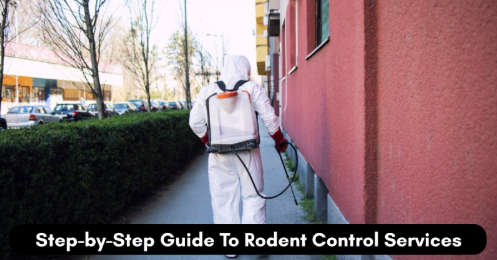Mice and rats are not merely a nuisance; they can be life-threatening and damage home and business structures. Moreover, they reproduce quickly and can adapt to different environments; therefore, early detection and control are very important.
That said, the initial step in managing the infestation is to identify its signs. Droppings, gnaw marks, damage to packaging material, oil spots on walls, and scratching noises within walls are some blatant signs of rodents.
Uncontrolled rodents may contaminate food, transmit diseases and destroy property.
Thus, hiring an organized rodent control service is crucial in protecting your health and property. An integrated method by such services incorporates inspection, sanitation, exclusion and treatment approaches that are specific to the needs of your home or business.
This article discusses a step-by-step approach implemented by rodent control services that helps to address infestations most efficiently, reduce risks, and avoid future infiltrations.
-
Identify Signs Of Rodent Infestation
Professional rodent control service is initiated by first confirming the presence and magnitude of infestation. Signs like droppings, chewed objects, and gnawed food containers, as well as suspicious sounds (scratches) that can be heard during the night, indicate active rodents.
Other indicators include smears of grease, nesting materials like torn fabric or paper, footprints, and a smelly or ammonia-like odor.
Observing these symptoms can help develop an accurate rodent control plan, ensuring every infected area is covered effectively and infestations are eradicated on time before they cause any additional harm.
-
Conduct A Thorough Inspection
Post identification of rodent infestation, the rodent control service team starts an in-depth analysis of the premises. Professionals determine the degree of infestation and find the entry points and environmental factors that lure rodents.
Some of the common entries are holes around piping, vents, doors, and cracks in the foundation.
Intensive inspection of attics, basements, kitchen, garage, and storage rooms makes sure that all infestations are detected. Sheds and under decks are also inspected. The findings of the inspection are the basis of a tailored managerial plan.
Overall, early detection of nesting places enables professionals to eliminate rodents more effectively and apply control measures that address the behavioral tendencies in rodents.
-
Sanitation Measures
Rodent control specialists state that sanitation is the foundation of effective rodent control. In the process, technicians recognize and either eradicate or assist in removing potential attractants, such as poorly stored food, open garbage cans, and piles of garbage.
They suggest measures such as keeping food in airtight containers, keeping storage areas dry, washing food-preparation surfaces regularly, and discarding garbage frequently. Professionals also recommend trimming overgrown plants, sealing dumpsters, and removing litter, which attracts rodents.
A clean environment restricts the breeding and encourages the success of other control measures, making sure that infestation does not recur soon.
-
Exclusion And Prevention
Rodent control services lay much emphasis on exclusion, which can prevent future infestations by sealing entry points. Once gaps are detected, technicians fill up the openings with material that is long-lasting, like steel wool, metal flashing, hardware cloth, and weather stripping.
They also install door sweeps, mesh coverings on vents, and secure chimney caps to prevent rodents from re-entering the building.
Moreover, traps or bait stations are strategically placed in high-risk areas where rodents are most likely to attempt entry.
Rodent management professionals create long-term control measures by integrating exclusion with environmental management, which greatly mitigates the chances of reinfestation.
-
Treatment Methods
Specialists begin treatment once sanitation and exclusion are completed. They use a combination of mechanical, chemical, and occasionally, biological methods depending on severity and the position of the infestation.
Mechanical techniques include snap traps, live traps, and electronic traps, which provide quick, effective rodent removal.
The application of chemical treatments, including rodenticides, is done in a careful and limited manner to reduce the risks to people, pets and non-target wildlife.
Professionals can combine several measures at once in case of large or repeated infestations to be as effective as possible. These services also adhere to principles of Integrated Pest Management (IPM), where the least-toxic approach is used initially, and more lethal approaches are used only where the activity is persistent.
Each treatment plan is developed according to the property’s layout and rodent behavior, ensuring effective elimination and adherence to safety policies.
-
Monitor And Follow-Up
To track the success of control measures, continuous monitoring is used, and rodent trapping is avoided. Professionals also make follow-up visits, screen traps, monitor for emergent signs of activity, and modify preventive interventions as necessary.
Homeowners and business operators are advised to ensure that the premises are regularly cleaned, new holes in the structures are filled, and they are on the lookout for early signs of reinfestation. In commercial environments, technology could be utilized, such as motion-activated cameras or tracking devices, to monitor activity.
Frequent monitoring is critical for maintaining rodent-free conditions and obtaining meaningful data to enhance long-term control measures.
The Takeaway
A rodent control service is a professional service implemented through a properly designed process that combines detection, inspection, sanitation, exclusion, treatment, and monitoring. Every stage aims to address the sources of infestation, both directly and preventively.
Early detection enables targeted control, whereas continuous follow-up ensures sustainable outcomes. Rodent control professionals protect both health and property using scientifically proven methods and safety measures.
This organised strategy not only removes current infestations but also builds long-term resistance to prevent future invasions, facilitating cleaner, healthier, and safer working and living conditions for all people.

